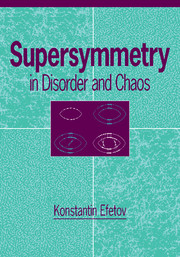Book contents
- Frontmatter
- Contents
- Preface
- Acknowledgments
- 1 Introduction
- 2 Supermathematics
- 3 Diffusion modes
- 4 Nonlinear supermatrix σ-model
- 5 Perturbation theory and renormalization group
- 6 Energy level statistics
- 7 Quantum size effects in small metal particles
- 8 Persistent currents in mesoscopic rings
- 9 Transport through mesoscopic devices
- 10 Universal parametric correlations
- 11 Localization in systems with one-dimensional geometry
- 12 Anderson metal–insulator transition
- 13 Disorder in two dimensions
- 14 Afterword
- Appendix 1 Calculation of the Jacobian
- Appendix 2 Magnetic field parametrization
- Appendix 3 Density–density correlation function at k = 0
- Appendix 4 Effective medium approximation as a saddle point
- References
- Author index
- Subject index
12 - Anderson metal–insulator transition
Published online by Cambridge University Press: 10 November 2010
- Frontmatter
- Contents
- Preface
- Acknowledgments
- 1 Introduction
- 2 Supermathematics
- 3 Diffusion modes
- 4 Nonlinear supermatrix σ-model
- 5 Perturbation theory and renormalization group
- 6 Energy level statistics
- 7 Quantum size effects in small metal particles
- 8 Persistent currents in mesoscopic rings
- 9 Transport through mesoscopic devices
- 10 Universal parametric correlations
- 11 Localization in systems with one-dimensional geometry
- 12 Anderson metal–insulator transition
- 13 Disorder in two dimensions
- 14 Afterword
- Appendix 1 Calculation of the Jacobian
- Appendix 2 Magnetic field parametrization
- Appendix 3 Density–density correlation function at k = 0
- Appendix 4 Effective medium approximation as a saddle point
- References
- Author index
- Subject index
Summary
Description of phase transitions
Phenomenological approach
Some basic information concerning theory of the Anderson metal–insulator transition has been given in Chapters 3 and 5. The agreement of the one-parameter scaling hypothesis of Abrahams et al. (1979) with the results of the renormalization group treatment of the nonlinear replica and supermatrix σ-models in 2 + ∈ dimensions was considered by many researchers final proof that the transition was a conventional second-order transition. The only thing that remained to be done was to compute critical exponents, and that could be done by making an expansion in ∈ and putting ∈ = 1 at the end. Other approximate schemes (Götze (1981, 1985), Vollhardt and Wölfle (1980, 1992)) lead to similar results. Although agreement between the exponents computed analytically and those extracted from numerical simulations or experiments was not always good, the validity of the one-parameter scaling description was not usually questioned.
Of course, on the basis of what is known about mesoscopic systems one cannot speak of the average conductance of a finite system, and, possibly, the entire distribution function of the conductances should be scaled. However, renormalization group treatment of the σ-model in 2 + ∈ dimensions does not lead to such a scenario. If one accepts that this approach is appropriate for studying the Anderson transition, the conclusion that the transition is a conventional second-order phase transition is inevitable.
- Type
- Chapter
- Information
- Supersymmetry in Disorder and Chaos , pp. 318 - 375Publisher: Cambridge University PressPrint publication year: 1996

